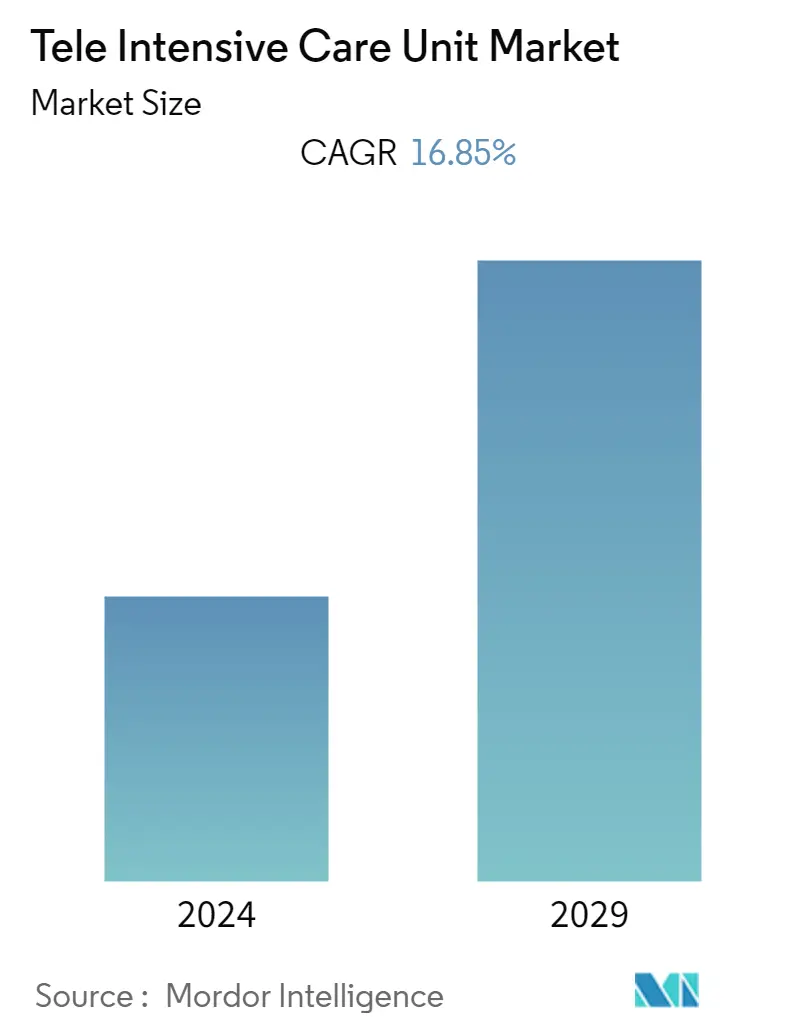Market Size of Tele Intensive Care Unit Industry

| Study Period | 2019 - 2029 |
| Base Year For Estimation | 2023 |
| CAGR | 16.85 % |
| Fastest Growing Market | North America |
| Largest Market | North America |
| Market Concentration | Medium |
Major Players
*Disclaimer: Major Players sorted in no particular order |
Need a report that reflects how COVID-19 has impacted this market and its growth?
Tele Intensive Care Unit Market Analysis
The tele-intensive care unit market is expected to register a CAGR of 16.85% during the forecast period.
The COVID-19 pandemic significantly impacted the growth of the market. Telemedicine is one of the promising technologies, as critical care specialists from ICU telemedicine centers were crucial in expanding critical care services during the COVID-19 pandemic. Also, several initiatives and implementations were carried out by various government organizations and market players related to tele ICU, impacting market growth during the pandemic. For instance, in November 2021, the Gujarat government planned to enlist private physicians to launch tele-ICU services to lessen the burden on government hospitals and health centers in rural and remote locations that lack specialized physicians. Such initiatives by the government increased the adoption of tele-ICU services across hospitals. Thus, the studied market witnessed significant growth during the pandemic.
Factors such as an increase in the volume of surgical procedures worldwide and increasing demand for remote patient monitoring are anticipated to drive market growth.
The rising prevalence of chronic diseases coupled with the growing geriatric population raises the need to find new ways of improving patient outcomes, increasing access to care, and reducing the cost of medical care. For instance, according to the Centers for Disease Control and Prevention (CDC), data updated in July 2022, in the United States, 6 in 10 adults suffer from a chronic disease, and 4 in 10 adults include two or more chronic diseases like heart disease, cancer, stroke, chronic obstructive pulmonary disease, and diabetes.
Additionally, according to an article published in Frontiers in Public Health in January 2023, the number of people in the United States is projected to reach 221.13 million in 2050, representing a 61.11% increase from the last three decades. Also, as per the same source, about 142.66 million people aged 50 and older were projected to include at least one chronic disease by 2050, with an increase of 99.5%. Thus, the expected increase in elderly suffering from chronic diseases raises hospital admission rates. This is anticipated to fuel the demand for tele-ICU, propelling the market growth.
Furthermore, the advantages offered by tele-ICU such as the low-cost method of connecting intensivists with hospitals, earlier interventions for critically ill patients, allowing hospitals to provide these highly trained specialists to their most critically ill patients, increased awareness of high-acuity patients for proactive monitoring, improved care quality and adherence to key metrics, increased their adoption across the hospitals.
Moreover, the increasing launch of tele-ICU hubs in various countries is also expected to propel market growth. For instance, in May 2022, Manipur, India's Chief Minister, inaugurated the first-ever Tele-ICU Hub, including a 10-bed ICU ward at the Jawaharlal Nehru Institute of Medical Sciences (JNIMS), Imphal. With the Tele-ICU facilities, patients being treated at Intensive Care Units (ICU) in different district hospitals and other Tele-ICU-supported hospitals will be able to access observation by specialist doctors through the hub set up at JNIMS.
Therefore, owing to the factors above, such as the high prevalence of chronic diseases, the growing aging population, and the advantages of tele-ICU, the studied market is anticipated to grow over the forecast period. However, the high cost of treatment and expensive setup will likely hinder the growth of the tele-intensive care unit market over the forecast period.
